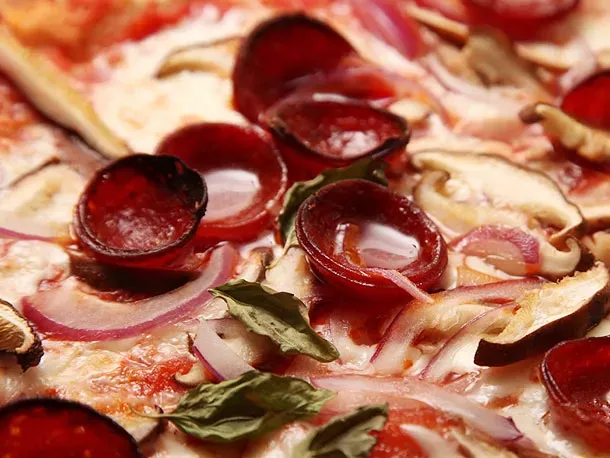Why Does Pepperoni Curl? (Serious Eats)

(…) There are times when I'll head into a bog-standard New York slice joint, see those pre-cooked squares with their flat disks of pepperoni, watch some poor sap order them, and think to myself: Ah, you've fallen victim to one of the two classic blunders, the most famous of which is "never question your pizza toppings in Asia," but only slightly less well known is this: "Never order a Sicilian when you spy flat-laying pepperoni on the line."
To me, flat pepperoni just doesn't fit the bill. It sits there, wan and pliable, its grease spreading over the top of semi-coagulated cheese like an oil spill, dripping off the edges of a slice, making the whole endeavor so treacherous that some folks even resort to blotting with paper napkins.
On the other hand, what you should be having is this:

As the pizza bakes, the edge of the pepperoni curls upwards, forming a distinct lip. Once exposed like this, the lip cooks faster than the base, which is insulated by the cheese and crust, and thus crisps and renders its fat faster. This fat drips down into the center of the cup. What you're left with is a gloriously flavorful little sip of pepperoni grease, neatly contained within its own, crisp-lipped edible container. The browned lip takes on an almost bacon-like quality — melt-in-your-mouth crunchy. It's one of the true joys of a pepperoni pizza, and once you've experienced it, plain old flat pepperoni just won't do. (…)
So where do we stand in the final analysis? We know of three factors that definitely affect curling:
- The way the meat is stuffed into its casing affects its shape inside the pepperoni stick. For the curliest pepperoni, look for pepperoni that was stuffed into a natural or collagen casing. Whether that casing is intact or not when you cook it makes no difference at all.
- The heat differential caused by uneven cooking between the top and the bottom of the slice. This enhances curl, and also determines the direction in which the pepperoni will cup. Thick slices are needed to maximize the temperature differential, but too thick and it becomes too stiff to curl. Go for slices between .1 inch (2.5 millimeter) and .225 (5.6 millimeter) range for optimal cuppage.
- The moisture retention ability of the center vs. the edges of the slice will enhance cuppage, but since we have no control over this, it shouldn't affect your shopping or slicing decisions.
This entire exploration was basically just a fascinatingly roundabout way of coming to a conclusion that I think most of us already knew: For the cup-iest pepperoni, get natural casing, and slice it medium-thick. (…)
/__opt__aboutcom__coeus__resources__content_migration__serious_eats__slice.seriouseats.com__images__2012__12__20121211-pepperoni-curl-pizza-lab-01-6109e17ffa4a487b855011d9f0f1a55d.jpg)

